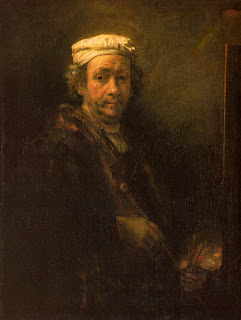Son Rembrandt van Rijn
Nacionalidad: Holanda
Leiden 1606 - Amsterdam 1669
Style: Baroque Central • Gallery
Harmenszoon Rembrandt van Rijn, Dutch Baroque painter, born in Leiden on July 15, 1606. The son of a mill belonging to the Dutch middle class, so he attended the Latin School and in 1620 enrolled at the University of Leiden, although unknown to what matters. In 1621, leaves for college and began his artistic training in his hometown with an obscure painter named Jacob van Swanenburgh, in whose workshop was three years. Between 1624 and 1625 before continuing his studies in Amsterdam, this time in the studio of a painter of greater importance, Pieter Lastman, who takes the influence of Caravaggio and Elsheimer. You may also frequented another workshop, Jacob Pynas, Italian style. In 1625 we are again in Leiden, where he opened the workshop with Jan Lievens, who had met in the study of Lastman. In these years is his first known work, the Stoning of St. Stephen, where the influence is clearly seen Caravaggio. In 1628 his reputation is already considerable and has disciples in charge, noting Gerrit Dou. When his father died in 1630, leaving Leiden Rembrandt and settled in Amsterdam, in association with art dealer Hendrick van called Uylemburgh, who provides interesting commissions, especially portraits where the artist puts all his attention, capturing the soul of the sitter details and prices of clothing, thus increasing his fame and fortune. In 1632 performing one of his most famous works, The Anatomy Lesson of Dr. Tulp, which had enormous success. Their economic situation is very successful and will be even more on marriage in 1634 to Saskia van Uylemburgh, niece of his partner and holds an excellent feat. Saskia will become the first bastion of the painter's life and the protagonist in many works such as Self-Portrait with Saskia Saskia or a hat. The 1630 is a remarkable success for the artist, with works of religious themes as the sacrifice of Isaac, or The wedding of Samson, excellent scenery and magnificent self-portraits. However, 1642 will not be a good souvenir for Rembrandt and Saskia dies - some months after giving birth to their only surviving child, Titus - and his painting The Night Watch received an icy reception from critics. From that moment, the orderly and successful life Rembrandt suffered hard blows both economic - getting to the total bankruptcy in 1656 - as loving and social with the lawsuits with Geertje Dircks, his son Titus nanny, who accused him of having made promise of marriage, or accusations of living in concubinage with her maid Heindrickje Stofeels, a girl who will become the livelihood of the artist's final years and works as a model of multiple Hendrickje in bed. Despite these unfortunate events, the art of Rembrandt forward, left the baroque exuberance but is enriched with vibrant colors and a huge attention to detail, creating new iconography appropriate to the Protestant mentality as The Supper at Emmaus and Christ and the adulteress . Orders reappear in the 1660s, highlighting the Anatomy Lesson of Dr. Deyman, The Trustees of the clothiers' guild or The Jewish Bride. In all cases we find that "rough manner" that characterized his last decades, in which the long stroke, bound, will be the main protagonist, without underestimating the role of golden light, with which manages to create atmospheric effects de calidad insuperable, tomando como referencias a la Escuela veneciana y Tiziano. Rembrandt fallece en Amsterdam el 4 de octubre de 1669 a la edad de 63 años, siendo uno de los más innovadores y excepcionales artistas de todos los tiempos.
http://www.artehistoria.jcyl.es/genios/pintores/3104.htm





























0 comments:
Post a Comment